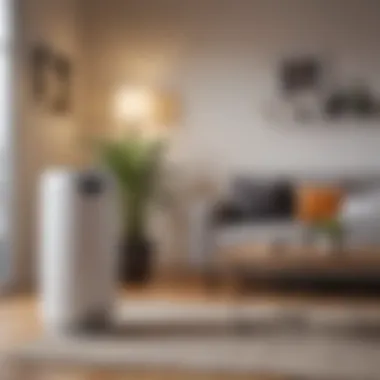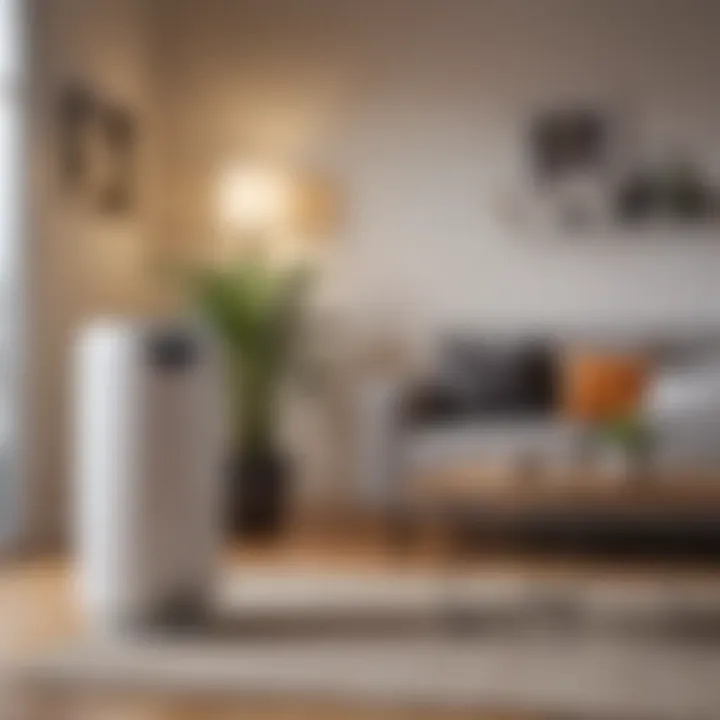Do Ozone Air Purifiers Really Improve Air Quality?


Intro
Understanding the complexities of indoor air quality is essential, especially for pet owners. As we strive to create a healthier environment for our furry companions, the tools we choose can greatly impact their well-being. Ozone air purifiers have gained attention as potential solutions for improving air quality. However, there’s a fair amount of controversy surrounding their use, particularly when it comes to the safety of pets and humans alike
This article will delve into the workings of ozone air purifiers, their effectiveness against various pollutants, and the health implications of ozone exposure. With pets often being sensitive to environmental changes, it’s crucial to comprehend what these devices can and cannot do before making a decision.
Understanding Ozone Air Purifiers
Ozone air purifiers operate on the principles of generating ozone. This three-atom form of oxygen is designed to eliminate odors and pollutants. When ozone encounters these contaminants, it reacts chemically, detoxifying the air. It’s important to note that while ozone can neutralize odors and some harmful compounds, it is not entirely without risk.
Here’s a breakdown of how these devices typically function:
- Generation of Ozone: Most models use electrical discharges to create ozone from oxygen in the air.
- Reaction with Pollutants: The ozone seeks out and interacts with common indoor air contaminants such as smoke, mold, and pet dander.
- Neutralization: Ideally, the reaction leads to a breakdown of these pollutants into less harmful substances.
However, there’s much debate about the effectiveness and safety of such devices, particularly in homes with pets.
The Effectiveness Against Pollutants
The effectiveness of ozone air purifiers can vary widely depending on several factors:
- Concentration of Ozone: Higher levels might enhance odor neutralization, but also increase risks.
- Type of Pollutant: Some studies suggest ozone is more effective against certain chemical compounds but less so against particulates like dust or hair.
Here’s what experts say about specific pollutants:
- Odors: Generally, ozone can help reduce strong odors in confined spaces, including pet odors.
- Bacteria and Viruses: While ozone may kill certain microorganisms, it can be less effective against all pathogens.
- Pesticides and Chemicals: Evidence about ozone’s ability to remove these compounds is mixed, leading to uncertainty about its overall effectiveness.
Ozone is not selective. It will react with whatever is in the air, which can sometimes create new pollutants.
Health Implications of Ozone Exposure
When discussing ozone air purifiers, one cannot overlook the potential health risks associated with ozone itself. It’s known that ozone, when inhaled, can be harmful to respiratory health. The following points outline important considerations:
- Respiratory Issues: Pets and humans with pre-existing respiratory conditions may be at risk.
- Irritation: Ozone can cause irritation in eyes, throat, and lungs, affecting not just pets but everyone in the household.
- Cancer Risk: Long-term exposure to ozone has raised concerns about cancer risks.
In light of these factors, pet owners must weigh the benefits of ozone air purifiers against potential health risks. Many experts recommend alternative air purification methods such as HEPA filters that do not produce ozone.
Closure
Navigating the world of air purification requires a solid understanding of the devices involved, particularly when pets are in the picture. With concerns surrounding health implications and effectiveness, it may be wise to thoroughly research and consider all options before purchasing an ozone air purifier. By doing so, you’ll be taking an informed step towards creating a healthier environment for your beloved companions.
Preamble to Ozone Air Purifiers
The topic of ozone air purifiers holds significance in the context of enhancing indoor air quality, especially for households with pets. These devices have surged in popularity, with many pet owners intrigued by the promise of cleaner air. Understanding how they function and the implications of their usage is crucial for making informed choices that ensure a healthier living environment.
Implementing air purification systems can be viewed as part of a broader commitment to maintaining a safe home for furry friends. The significance of discussing ozone air purifiers lies not only in their mechanism but also in the varying opinions surrounding their effectiveness and safety.
Understanding Ozone
Ozone, a molecule comprised of three oxygen atoms, often gets a mixed reputation. While it plays a critical role in the Earth’s stratosphere by shielding us from harmful ultraviolet radiation, ground-level ozone can be problematic. When created artificially for purification purposes, ozone is often employed in air purifiers to cleanse indoor spaces of pollutants. It’s essential to get a grasp on what ozone is and how it interacts with other substances in the air we breathe.
When ozone is introduced into the air, a chemical reaction occurs. It can interact with various pollutants, transforming them into less harmful substances. For example, when ozone meets volatile organic compounds—commonly found in household cleaners and paints—it may oxidize them, breaking them down into simpler compounds. However, there’s a fine line; while some reactions may mitigate pollution, they can also produce secondary pollutants, potentially affecting air quality negatively.
How Ozone Air Purifiers Function
The operation of ozone air purifiers hinges on the deliberate generation of ozone. Generally, these devices employ methods such as corona discharge or ultraviolet light to convert oxygen (O2) in the air into ozone (O3). The process typically takes place in a closed space, producing a concentration of ozone intended to target airborne contaminants including bacteria and fungi.
When activated, the purifier releases ozone into the room. The intention is for the ozone to seek out and neutralize particles that contribute to poor air quality.


This process of releasing ozone can be effective in theory, but practical effectiveness often raises eyebrows. The effectiveness of ozone air purifiers boils down to various factors, including the type and concentration of pollutants present, as well as the duration and extent of ozone exposure. Moreover, there are safety guidelines and recommendations that should be adhered to when utilizing these devices, to mitigate health risks associated with high levels of ozone in residential spaces.
Scientific Basis for Ozone Purification
Understanding the scientific underpinnings of ozone purification is crucial in evaluating the efficacy of ozone air purifiers. These devices employ ozone’s powerful oxidizing properties to eliminate a variety of pollutants in indoor environments. Providing a thorough analysis of how ozone interacts with different substances helps pet owners and families make informed decisions about these purification systems. The mechanisms, benefits, and eventual drawbacks of ozone handling reveal both potential advantages and health considerations.
Chemical Reactions Involved
Ozone, a triatomic form of oxygen, engages in a series of chemical reactions that can break down and neutralize harmful pollutants. When ozone encounters organic molecules—like bacteria, allergens, and VOCs—it forms various byproducts, which often include less harmful substances. This interaction can significantly reduce the presence of odors and pathogens in the air.
Instead of merely recirculating air, ozone acts as a disinfectant. When ozone meets these compounds, it disassembles them through oxidation, a process where electrons are stripped from pollutants, transforming them into simpler, often non-toxic forms. While this is beneficial for cleaning the air quality, a careful balance must be taken into account.
"Ozone can be great for reducing smells and killing microbes. But too much can cause problems of its own—finding the right equilibrium is key."
The intensity and effectiveness of this reaction depend on several factors, including the concentration of ozone and the time it spends in contact with the pollutants. Also, it's essential to ensure adequate ventilation during operation, to prevent any unwanted buildup of ozone in living spaces.
Types of Pollutants Targeted
Understanding the types of pollutants that ozone purifiers can effectively target sheds light on their practicality in home environments. Ozone often tackles two main categories of air contaminants: volatile organic compounds and odors, including smoke.
Volatile Organic Compounds
Volatile Organic Compounds, or VOCs, include a wide range of chemicals that can easily evaporate at room temperature. Common sources are household products, such as paint, cleaning supplies, and air fresheners. These substances are notorious for lowering indoor air quality, leading to various health issues such as headaches or even respiratory problems.
A key characteristic of VOCs is their ability to exist in a gaseous form, which allows ozone to engage in effective reactions with them. This feature makes VOCs a significant target for ozone purifiers. By breaking down these compounds into harmless byproducts, ozone purifiers can contribute to a fresher, more breathable environment, particularly in spaces where pets roam.
However, it’s worth noting that while ozone can be effective against VOCs, it may not eliminate them entirely—some byproducts can be just as harmful. Therefore, relying on ozone as the sole solution could potentially lead to delusion regarding indoor air quality.
Odors and Smoke
The odors that linger from cooking, furniture, or even pet dander can be tackled effectively by ozone purifiers. The very nature of ozone allows it to counteract smells by interacting and breaking down odor-causing molecules. When ozone transforms these malodorous compounds into less pungent substances, the air quality improves significantly.
These odors are often problematic and can be persistent. Ozone’s unique qualities make it a likely candidate for combating such smells. However, just as with VOCs, ozone treatment might require a good dose of caution—while odors can vanish, ozone itself can create a lingering scent that some find off-putting.
In summary, while there’s a lot to consider when utilizing ozone to target both VOCs and odors, potential benefits might come with certain risks. Families with children or pets should weigh these factors while deciding whether an ozone air purifier is right for their home. The technology surely has its rationale in removing various pollutants, but understanding the chemistry involved ensures a more considered approach.
Effectiveness of Ozone Air Purifiers
Understanding how ozone air purifiers perform is key to discerning their role in enhancing indoor air quality. The pursuit of cleaner air inside the home isn’t just a luxury; it's a necessity, especially for those who have pets or suffer from allergies. Correctly evaluating the effectiveness of ozone air purifiers sheds light on their potential benefits and pitfalls.
Reviewing Empirical Studies
When diving into the effectiveness of ozone air purifiers, it's prudent to look at empirical studies. These studies often provide a snapshot of real-world scenarios, showcasing whether these devices deliver on their promises. Several investigations have demonstrated mixed outcomes. For instance, some studies suggest that ozone can effectively reduce odors and certain bacteria in controlled environments. However, the flip side highlights that elevated ozone levels can lead to health concerns for humans and pets alike.
This warrants a closer look at how ozone interacts with various indoor pollutants. One study, conducted over a four-month period, measured ozone concentrations along with airborne particulate matter before and after installing an ozone air purifier. The results indicated a decrease in some pollutants, but notably, ozone levels surpassed safe exposure limits.
Comparative Analysis with Other Purification Methods
Putting ozone air purifiers to the test against other filtration methods brings clarity to their standing in indoor air quality management.
HEPA Filters
High-Efficiency Particulate Air (HEPA) filters have garnered a reputation as reliable for trapping allergens and particulates. The specific aspect of HEPA filters is their ability to filter out 99.97% of particles that are 0.3 microns or larger. This characteristic is crucial, especially for homes with pets, where dander and hair could aggravate allergies.
Their unique feature is that HEPA filters do not generate ozone as a byproduct of their operation, making them a popular choice among families looking for a safe solution for respiratory health. Despite requiring periodic replacements, consumers lean toward HEPA filters for their effectiveness without the collateral damage that ozone exposure can entail.
Activated Carbon Filtration
Activated carbon filters engage in a different approach, focusing on adsorption rather than filtration. Their porous structure allows them to trap gases and odors effectively. The significance of activated carbon filtration lies in its ability to target smoke and volatile organic chemicals, which are common indoor air pollutants. This method is valuable, especially in homes with pets that may stir up odors.


The notable characteristic of activated carbon is its extensive surface area, making it capable of adsorbing many harmful substances. However, like any filtration system, its effectiveness depends on factors such as the flow rate and the level of pollutants. While it serves as a strong complement to HEPA filters, it can only target specific odor and chemical components and may require frequent replacement.
Health Implications of Ozone Exposure
Understanding the health implications of ozone exposure is critical for anyone considering the use of ozone air purifiers. While these devices claim to improve indoor air quality, it is essential to be aware of the potential risks they pose to both humans and pets. With pets often roaming freely in various living spaces, it becomes paramount to evaluate how ozone might affect their health, along with the well-being of children and other family members.
Potential Health Risks
Respiratory Issues
Respiratory health stands at the forefront of concerns when discussing ozone exposure. Small particles and gases can irritate breathing passages, leading to inflammation and reduced lung function. For many, this is no small potatoes—especially for children or elderly individuals who might already have fragile respiratory systems.
When ozone combines with other pollutants, it can even enhance the effects of these irritants, making them more detrimental. Allerigies and asthma can flare up, particularly for households already burdened with these issues. In terms of overall health, it’s a slippery slope; what might start as a casual sniffle could devolve into more severe respiratory problems. Therefore, understanding the key characteristic of ozone as an air purifier is crucial; despite its purported benefits for certain air pollutants, its contributions to respiratory troubles cannot be overlooked.
Long-term Exposure Concerns
Long-term exposure to ozone presents its own set of fears. Prolonged inhalation of ozone can lead to chronic respiratory issues, and in some cases, it may even predispose individuals to lung damage. This makes it more than just a passing concern; rather, it signifies the need for caution.
A key characteristic of long-term exposure is the gradual buildup of harm that often sneaks up on individuals. It can affect not only humans but also pets, creating a household teetering on a health crisis without prior warnings. The unique feature of cumulative exposure means that the toll ozone takes isn't immediately apparent. Some may argue that an unsuspected challenge lurks behind using these devices—assuming they provide clean air might lead to a false sense of security.
"While ozone can intake certain drafts of odors, inhaling it regularly can leave individuals gasping for more than just fresh air."
Guidelines for Safe Use
Given the potential risks, it becomes necessary to consider some guidelines for safe usage of ozone air purifiers.
- Ventilation: Always ensure that the area where the ozone purifier operates is properly ventilated. Airing out the space can dilute ozone concentrations.
- Usage Timing: Use the purifiers when the home is unoccupied. It would be prudent to leave the house while the device operates, thus minimizing any inhalation of ozone.
- Follow Manufacturer Instructions: Adhere strictly to the guidelines laid out by the manufacturer when using ozone generators. This can help maintain safe levels of ozone exposure.
In summary, the health implications associated with ozone exposure are multifaceted. Although ozone air purifiers may seem like a quick fix for cleaner indoor air, they come with considerable risks that pet owners and families should carefully weigh. Understanding these implications ain't just smart; it could mean the difference between a healthier living environment and an avoidable health threat.
Regulatory Standards and Recommendations
Understanding the landscape of ozone air purifiers cannot be complete without assessing the regulatory standards that guide their use. These regulations play a crucial role in ensuring that consumers can make informed decisions, especially when the health of humans and pets is at stake. The guidelines set forth by various regulatory bodies, particularly the Environmental Protection Agency (EPA), help establish boundaries that aim to protect users from the potential harms posed by ozone exposure.
When it comes to air quality, ozone levels are a significant concern. High concentrations of ozone can cause adverse health effects, particularly for vulnerable populations like children and pets. Therefore, having a clear understanding of these regulations is essential for any pet owner or family looking to enhance their living environment without inadvertently compromising safety.
Overview of EPA Guidelines
The EPA has developed extensive guidelines regarding ozone levels in air purifiers, central to which is the recommended limit for ozone emissions. According to the EPA, ozone concentrations in indoor air should not exceed 0.05 parts per million (ppm). To put this into perspective, some ozone air purifiers have been shown to emit levels significantly higher than this suggested threshold. This discrepancy is concerning, as it could lead to long-term exposure risks, especially for kids and pets who may be more susceptible to respiratory conditions.
Here are some key points from the EPA guidelines:
- Ozone Emission Standards: The EPA indicates that products should ideally emit no more than 0.05 ppm of ozone.
- Safety Recommendations: The agency suggests using ozone-generating devices only in unoccupied spaces. This caution reflects the idea that while ozone can neutralize certain pollutants, its benefits must be weighed against its potential risks.
- Labeling Requirements: Devices marketed as air purifiers must clearly state that they produce ozone, helping consumers make well-informed decisions.
These guidelines are vital, offering a governmental perspective on air quality management and raising awareness about the implications of using ozone generators.
Consumer Safety Recommendations
While regulatory standards provide a framework, consumer safety practices can dramatically enhance the effectiveness of ozone air purifiers while keeping risks to a minimum. Pet owners and families with children should consider the following recommendations:
- Prioritize Products with Low Ozone Emissions: When shopping for air purifiers, look for models that clearly comply with EPA standards. Brands like Airmega and IQAir have been recognized for their commitment to safety.
- Usage Timing: Operating these purifiers when the space is empty reduces the risk of inhalation from elevated ozone levels. Timing your usage just before a gathering or at night can be a smart strategy.
- Ventilation: Ensure adequate ventilation in areas where you use ozone air purifiers. Open windows and doors can help dissipate ozone levels faster, thereby protecting your family and pets.
- Regular Monitoring: Consider investing in an air quality monitor that can measure ozone levels. This knowledge gives peace of mind and ensures that indoor conditions are always within safe limits.
"Safety first should be the motto, especially when you’re considering purifiers that can produce harmful substances."
By adhering to these consumer safety recommendations and being aware of regulatory guidelines, families can protect their loved ones while exploring the potential benefits of ozone air purifiers.
Alternatives to Ozone Air Purifiers


As the quest for cleaner indoor air continues, many individuals, especially pet owners and families with children, are on the lookout for viable alternatives to ozone air purifiers. While ozone generators claim to improve air quality by eliminating pollutants, their potential health risks often spark concern. Hence, exploring alternatives is not just a good idea, it's essential for informed decision-making about maintaining a healthy home.
Natural Air Purifiers
Natural air purifiers include plants that can enhance indoor air quality through their natural processes. These green companions aren't just for decoration; they can absorb carbon dioxide and release oxygen, creating a fresher environment. Among the most effective are:
- Spider Plant: Not only is it easy to care for, but it also helps in absorbing hazardous pollutants.
- Peace Lily: This beauty thrives in low light while effectively filtering out harmful substances.
- Boston Fern: Known for its ability to remove formaldehyde from the air, it requires more humidity but can be a great addition for moist environments.
Natural methods, like introducing these plants into your living space, are often favorable since they bring a slice of nature indoors while cleaning the air. However, it’s worth noting that while they may help in reducing certain toxins, they’re not a complete replacement for mechanical systems and should be part of a wider air quality management strategy.
Mechanical Air Purification Systems
Mechanical air purification systems have become a staple in many homes. These systems utilize various filtration methods to effectively removes particles and pollutants from the air, providing a strong alternative to ozone generation. Here are a few types worth considering:
- HEPA Filters: These high-efficiency particulate air filters trap at least 99.97% of particles that are 0.3 microns in diameter. They're highly effective for those with allergies or respiratory conditions.
- Activated Carbon Filters: These filters absorb odors and gases, making them particularly useful in kitchens or areas where pets reside. They work by chemical adsorption, capturing pollutants on a porous surface.
- UV-C Light Systems: Some advanced air purifiers use ultraviolet light to kill bacteria and viruses. This technology doesn’t rely on ozone and can provide peace of mind in homes with vulnerable individuals.
"While ozone air purifiers may target certain odors, mechanical systems provide a comprehensive solution for reducing allergens and harmful particles."
Adopting one of these alternatives can significantly enhance indoor air quality without the concerns associated with ozone exposure. As technological advancements progress, choosing a suitable air purification method becomes vital, taking into account individual health needs and environmental considerations.
In the end, whether it's embracing the fresh vibes from indoor plants or opting for efficient mechanical systems, both aspects play a pivotal role in keeping the air you and your loved ones breathe clear and safe.
Making an Informed Decision
When it comes to selecting an air purification system, the terrain can be tricky to navigate. Ozone air purifiers, with their touted ability to eliminate odors and harmful pollutants, present a mixed bag of benefits and pitfalls. Understanding how to make an informed decision is pivotal for ensuring the health and safety of your household—particularly if furry friends or small children are part of the picture. Having a clear grasp of what to evaluate before making a purchase sets you up for a sound investment rather than a potentially harmful mistake.
Factors to Consider Before Purchase
Room Size
The size of the room where an ozone air purifier will be used has a significant impact on its efficacy. Simply put, if the appliance is too small for the space, you might as well be shouting into the wind. On the flip side, an oversized unit might generate levels of ozone that can outpace safety recommendations. It’s important to pay attention to the CADR (Clean Air Delivery Rate) listed by manufacturers to determine if the unit can effectively handle your particular room size.
This becomes even more crucial if you have open areas where air circulation plays a critical role. A well-sized ozone air purifier can efficiently treat the air, effectively tackling the unwanted odor and irritants that your pet might bring along, making it a solid choice for pet owners. Moreover, this factor combines nicely with ventilation; if the air doesn’t change frequently, larger units may provide diminishing returns, leading to wasteful exposure to ozone.
Specific Air Quality Concerns
Delving into specific air quality concerns means understanding what you aim to improve. Whether it's tackling allergens, smoke, or odors, pinpointing your major issue can greatly influence your decision-making process. For instance, if you live in a highly polluted area or in a household with smokers, seeking out a product designed for removing those specific contaminants can provide more targeted results.
Evaluating the unique features of ozone air purifiers for these particular issues is critical. These devices are often packed with options like different settings for treating pet odors, but you must weigh whether the ozone produced could exacerbate potential respiratory issues for both humans and pets. Moreover, incorporating these considerations not only helps in selecting the right device but also ensures that your investment yields tangible returns in terms of cleaned air.
Assessing Product Reviews and Ranges
Once you’ve narrowed down considerations like room size and air quality concerns, it’s time to dive into reviews—often a treasure trove of insights. Look for feedback from real users, especially pet owners or families with young kids. Pay close attention to comments on efficacy, usability, and any potential health implications experienced by users.
When exploring the market, examine a range of ozone air purifiers with respect to their features and price points. This can help in identifying a model that fits your specific needs while staying within a reasonable budget. Always compare not just features but also warranty and customer service; those elements can assure peace of mind long after the initial purchase.
"An informed choice is the first step in creating a healthier indoor space, where pets can play and families can breathe freely."
By taking these steps, you significantly increase the likelihood of bringing home a unit that not only does its job effectively but also safeguards your family’s health, creating a balanced environment for all. Remember, the goal is not just about removing contaminants but doing so in a way that keeps you and your loved ones healthy.
Ending
As we wrap up this investigation into ozone air purifiers, it's crucial to take stock of what we have examined. Ozone generators have been marketed as a solution for indoor air contamination, and understanding their true effectiveness can make a world of difference, especially for families with pets or small children.
Final Thoughts on Ozone Air Purifiers
In the end, the efficacy of ozone air purifiers boils down to a few pivotal factors:
- Mechanism of Action: It’s essential to grasp how these purifiers work. They produce ozone to eliminate odors, smoke, and certain pollutants. However, high levels of ozone can have health implications.
- Health Concerns: Potential health risks associated with ozone exposure – particularly respiratory issues – must not be overlooked. For households with pets or children, even a moderate exposure may raise red flags.
- Regulatory Insights: The guidelines from regulatory bodies, such as the Environmental Protection Agency, suggest caution. These guidelines advise consumers to consider the amount of ozone emitted by these devices and the duration of exposure.
- Alternative Solutions: Practical alternatives like HEPA filters and activated carbon systems are known for their ability to trap particulates without emitting harmful gases.
- Informed Decision Making: Before diving into a purchase, it’s wise to contemplate the specific needs of your environment. Assessing product reviews and understanding room size and air quality issues can empower you to make an educated choice.
"The effectiveness of ozone air purifiers is often clouded in controversy, so thorough research is paramount".
So, when evaluating the potential of ozone air purifiers, ask yourself: Are they suited for your specific needs? Would it be more prudent to explore safer alternatives?
In finishing up, knowledge is your best ally in maintaining a healthy home atmosphere for both you and your pets. Balancing the benefits and drawbacks of these purifying devices can lead you on the right path toward superior indoor air quality.







